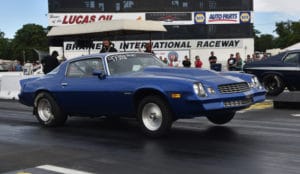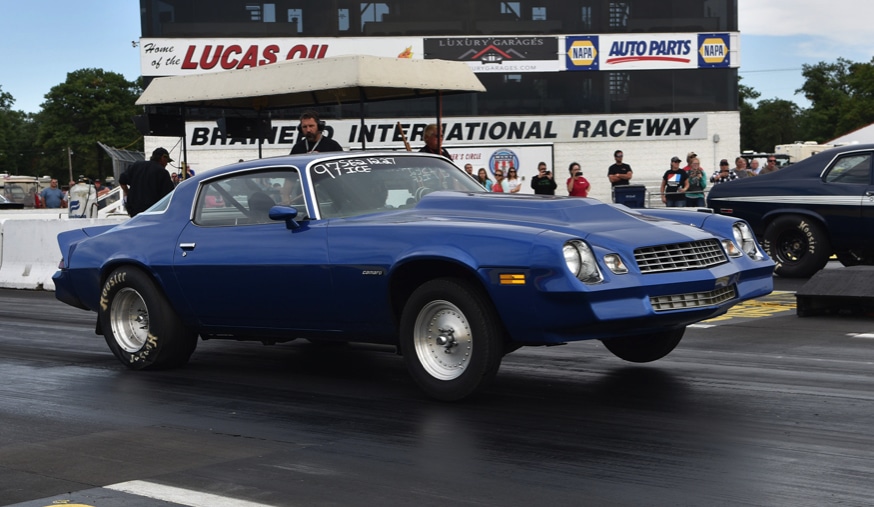by Dennis Dalman
news@thenewsleaders.com
“Like father like son” describes Gary and Nate Olson of Sartell to a T. Both work at the same place and both emerged as winners, once again, at the Muscle Car Series Show & Go event at Brainerd International Speedway July 5-7.
Driving his trusty 1979 deep-blue Camaro, Nate Olson was tops in the Strip Eliminator 2 class, beating five drivers, one at a time, in the elimination rounds on Saturday, then earning champion status Sunday by defeating the sixth contender, Mike Brandt of Lexington. He was also runner-up in the Street Car Showdown class.
A total of 73 cars and drivers competed in the Eliminator 2 class.
Like his son, Gary Olson also won in an eliminator class – Strip Eliminator 1 in the final round, winning over Roger Peterson of Osage. Gary was also a runner-up in the 11.50 Index class.
At the events of late last year and early this year, Nate also won big-time, defeating driver after driver in the Strip Eliminator 2 class at both events, the 12.50 Index class twice, once at each event and the Index Championship class once. Also earlier this year, he was a runner-up in the Index Class Eliminator category. His cumulative racing record is now 33-2.
Like his father, Nate, 22, has been racing for nearly six years and is piling up win after win, just as Gary did some years ago when he was driving the Camaro that Nate now races. Gary, in recent years, has been racing with his 1971 spring-green Nova, the car that just had to come back to Gary. At one time the Nova was another of the Olson cars. It was, in fact, the very car in which Gary drove to his own wedding. The car was sold later, but long after it was sold Olson happened to come across the Nova once again and happily bought it back from its latest owner. It was like the return of a long-lost friend.
The Olsons compete with other drag racers in what is known as “bracket racing,” in which speed is not as important as a driver’s skills – how the care is handled, reaction times, consistency, intense concentration and other factors that can even include how humidity can affect the car.
Before each race, a driver selects what’s called a “dial-in” time based on intricate knowledge of the car. A dial-in time is the time estimated at when the car will cross the finish line. That time is then noted on the exterior of the car. The car with a slower estimated time gets a bit of a green-light headstart. The driver who finishes closest to his dial-in time in the fourth-mile drag race wins. The difference in finish times is often as slim as 4,000ths of a second, making ties virtually impossible. A typical dial-in time might be, say, 14 seconds from starting line to finish line.
“It’s a real struggle to get that dial-time,” Nate said, “because so many factors – even the temperature and humidity can affect it. But that’s the fun of it. Without the competition, racing would be boring. And the camaraderie among all the drivers is great. We all share good, positive experiences. The concentration you need in bracket racing is stressful but also thrilling.”
Gary and Nate Olson both work as diesel mechanics – different shifts – at the Gator Truck Center, a Volvo dealership in Sauk Rapids.

Nate Olson’s Camaro roars down a drag racetrack at Brainerd International Speedway.

Gary Olson stands in front of his muscle-car racer, a 1971 spring-green Nova.

Nate Olson with his deep-blue 1979 Camaro behind him, the very car with which his father, Gary, won so many races in years past.



